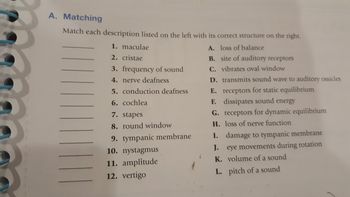
Human Anatomy & Physiology (11th Edition)
11th Edition
ISBN: 9780134580999
Author: Elaine N. Marieb, Katja N. Hoehn
Publisher: PEARSON
expand_more
expand_more
format_list_bulleted
Concept explainers
Question
Give typing answer to all parts?

Transcribed Image Text:A. Matching
Match each description listed on the left with its correct structure on the right.
A. loss of balance
B. site of auditory receptors
C. vibrates oval window
D. transmits sound wave to auditory ossicles
1. maculae
2. cristae
3. frequency of sound
4. nerve deafness
5. conduction deafness
6. cochlea
7. stapes
8. round window
9. tympanic membrane
10. nystagmus
11. amplitude
12. vertigo
1
E. receptors for static equilibrium
F. dissipates sound energy
G. receptors for dynamic equilibrium
H. loss of nerve function
I. damage to tympanic membrane
J. eye movements during rotation
K. volume of a sound
L. pitch of a sound
Expert Solution
This question has been solved!
Explore an expertly crafted, step-by-step solution for a thorough understanding of key concepts.
This is a popular solution
Trending nowThis is a popular solution!
Step by stepSolved in 3 steps

Knowledge Booster
Learn more about
Need a deep-dive on the concept behind this application? Look no further. Learn more about this topic, biology and related others by exploring similar questions and additional content below.Similar questions
- Which direction is exclusive to dyneins and which to kinesins? Motor proteins are required for the cell to operate normally. They are concentrating their attention on which structural protein.arrow_forwardExpand the term SCP?arrow_forwardDiscuss the components of a motor unit. What is the difference between a motor unit and a motor nucleus?arrow_forward
- In a neuron at rest, there is a difference in the electrical charge across the cell membrane, with the inside of the cell being more negative than the outside. This is primarily due to: a) secondary active transport of Na+ b) the difference in the concentrations of Na+ inside and outside of the cell c) simple diffusion of K+ ions d) leak channels increasing the permeability of the membrane to K+ ions e) facilitated diffusion of Na+ ionsarrow_forwardIn excitable cells, such as neurons, K+ is held at a much higher concentration inside the cell than outside. Which of the following would hold K+ at this concentration?arrow_forwardDescribe the structures and functions of actin-based cellular structures.arrow_forward
- What is affected by the electrical signal sent by the third structure? (This will be the fourth structure in the arc.) Where is the cell body of the fourth structure located? What is affected by the electrical signal sent by the fourth structure? (This will be the fifth structure in the arc.) What does the fifth structure do in response to that electrical signal and how does this action protect you? Describe a situation where a reflex arc would be activated that is not described in your lesson. Assume that the reflex arc has five components to it. Please choose a reflex that involves a body part below the neck. (If you have trouble with this, do an internet search for information on reflex arcs.)arrow_forwardif you move a fish from surface waters to deep depths (say deeper than 2000m), what physiological and biochemical mechanisms cause their muscle and neural function to be negatively affected? asap pleasearrow_forwardGive typed full explanation should you transport a patient on a spine board if they are wearing an niej? explain your answer.arrow_forward
arrow_back_ios
SEE MORE QUESTIONS
arrow_forward_ios
Recommended textbooks for you
 Human Anatomy & Physiology (11th Edition)BiologyISBN:9780134580999Author:Elaine N. Marieb, Katja N. HoehnPublisher:PEARSON
Human Anatomy & Physiology (11th Edition)BiologyISBN:9780134580999Author:Elaine N. Marieb, Katja N. HoehnPublisher:PEARSON Biology 2eBiologyISBN:9781947172517Author:Matthew Douglas, Jung Choi, Mary Ann ClarkPublisher:OpenStax
Biology 2eBiologyISBN:9781947172517Author:Matthew Douglas, Jung Choi, Mary Ann ClarkPublisher:OpenStax Anatomy & PhysiologyBiologyISBN:9781259398629Author:McKinley, Michael P., O'loughlin, Valerie Dean, Bidle, Theresa StouterPublisher:Mcgraw Hill Education,
Anatomy & PhysiologyBiologyISBN:9781259398629Author:McKinley, Michael P., O'loughlin, Valerie Dean, Bidle, Theresa StouterPublisher:Mcgraw Hill Education, Molecular Biology of the Cell (Sixth Edition)BiologyISBN:9780815344322Author:Bruce Alberts, Alexander D. Johnson, Julian Lewis, David Morgan, Martin Raff, Keith Roberts, Peter WalterPublisher:W. W. Norton & Company
Molecular Biology of the Cell (Sixth Edition)BiologyISBN:9780815344322Author:Bruce Alberts, Alexander D. Johnson, Julian Lewis, David Morgan, Martin Raff, Keith Roberts, Peter WalterPublisher:W. W. Norton & Company Laboratory Manual For Human Anatomy & PhysiologyBiologyISBN:9781260159363Author:Martin, Terry R., Prentice-craver, CynthiaPublisher:McGraw-Hill Publishing Co.
Laboratory Manual For Human Anatomy & PhysiologyBiologyISBN:9781260159363Author:Martin, Terry R., Prentice-craver, CynthiaPublisher:McGraw-Hill Publishing Co. Inquiry Into Life (16th Edition)BiologyISBN:9781260231700Author:Sylvia S. Mader, Michael WindelspechtPublisher:McGraw Hill Education
Inquiry Into Life (16th Edition)BiologyISBN:9781260231700Author:Sylvia S. Mader, Michael WindelspechtPublisher:McGraw Hill Education

Human Anatomy & Physiology (11th Edition)
Biology
ISBN:9780134580999
Author:Elaine N. Marieb, Katja N. Hoehn
Publisher:PEARSON

Biology 2e
Biology
ISBN:9781947172517
Author:Matthew Douglas, Jung Choi, Mary Ann Clark
Publisher:OpenStax

Anatomy & Physiology
Biology
ISBN:9781259398629
Author:McKinley, Michael P., O'loughlin, Valerie Dean, Bidle, Theresa Stouter
Publisher:Mcgraw Hill Education,

Molecular Biology of the Cell (Sixth Edition)
Biology
ISBN:9780815344322
Author:Bruce Alberts, Alexander D. Johnson, Julian Lewis, David Morgan, Martin Raff, Keith Roberts, Peter Walter
Publisher:W. W. Norton & Company

Laboratory Manual For Human Anatomy & Physiology
Biology
ISBN:9781260159363
Author:Martin, Terry R., Prentice-craver, Cynthia
Publisher:McGraw-Hill Publishing Co.

Inquiry Into Life (16th Edition)
Biology
ISBN:9781260231700
Author:Sylvia S. Mader, Michael Windelspecht
Publisher:McGraw Hill Education